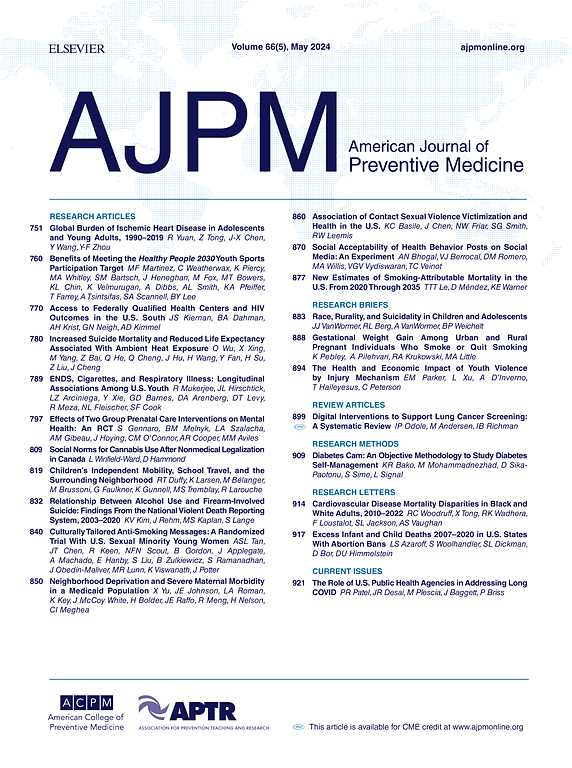Patterns of Breast Cancer Screening and Access to Care in a Safety-Net System
IF 4.5
2区 医学
Q1 MEDICINE, GENERAL & INTERNAL
引用次数: 0
Abstract
Introduction
Screening mammography reduces cancer-related mortality by detecting breast cancer at earlier stages. However, variable guidelines and limited access to primary care providers hinder screening uptake. This study characterizes screening mammography uptake patterns prior to breast cancer diagnosis within a safety-net system.
Methods
A retrospective study was performed to identify patients diagnosed with new invasive breast cancer between 2018 and 2019 at Parkland Health. Patients were categorized on the basis of screening mammography uptake: never screened (no screening mammography within 5 years of diagnosis), ever screened (last screening mammography between 2 and 5 years prior to diagnosis), and recently screened (screening mammography within 2 years of diagnosis).
Results
The study identified 468 patients with newly diagnosed breast cancer, with 237 (50.6%) never-screened, 113 (24.1%) ever-screened, and 118 (25.2%) recently screened patients. Among 57 women diagnosed at age <40 years, 15 (22.8%) were diagnosed with Stage IV breast cancer, and 24 (42.1%) had a primary care provider at time of diagnosis. Nodal status (p<0.001), tumor size (p<0.001), and stage (p<0.001) correlated with screening mammography uptake behaviors. Patients already established with primary care providers at time of diagnosis were more likely to have early-stage disease (p<0.001).
Conclusions
Half of the patients diagnosed with breast cancer did not have a mammogram within the preceding 5 years. In addition, 131 (27.9%) patients were aged between 40 and 49 years at diagnosis, reflecting the impact of a gap in prior screening guidelines, now addressed in the updated U.S. Preventive Services Task Force guidelines. Connecting patients with primary care providers and engaging in shared decision making may promote screening mammography uptake, especially in vulnerable patient populations.
乳腺癌筛查的模式和在安全网系统中获得护理的机会。
简介:筛查乳房x光检查(SMMG)通过在早期阶段检测乳腺癌来降低癌症相关死亡率。然而,不同的指导方针和获得初级保健提供者(pcp)的机会有限阻碍了筛查的采用。本研究描述了在安全网系统中乳腺癌诊断前的SMMG摄取模式。方法:对2018年至2019年在帕克兰健康中心诊断为新发浸润性乳腺癌的患者进行回顾性研究。患者根据SMMG摄取情况进行分类:从未筛查(诊断前5年内没有SMMG),曾经筛查(诊断前2至5年内最后一次SMMG)和最近筛查(诊断前2年内SMMG)。结果:该研究确定了468例新诊断的乳腺癌患者,其中237例(50.6%)从未筛查过,113例(24.1%)曾经筛查过,118例(25.2%)最近筛查过。在57名被诊断为40岁以下的女性中,15名(22.8%)被诊断为IV期乳腺癌,24名(42.1%)在诊断时患有PCP。结论:诊断为乳腺癌的患者中有一半在过去5年内没有做过乳房x光检查。此外,131例(27.9%)患者在诊断时年龄在40至49岁之间,反映了先前筛查指南差距的影响,现在在更新的USPSTF指南中解决了这一问题。将患者与pcp联系起来并参与共同决策可能会促进SMMG的吸收,特别是在弱势患者群体中。
本文章由计算机程序翻译,如有差异,请以英文原文为准。
求助全文
约1分钟内获得全文
求助全文
来源期刊

American Journal of Preventive Medicine
医学-公共卫生、环境卫生与职业卫生
CiteScore
8.60
自引率
1.80%
发文量
395
审稿时长
32 days
期刊介绍:
The American Journal of Preventive Medicine is the official journal of the American College of Preventive Medicine and the Association for Prevention Teaching and Research. It publishes articles in the areas of prevention research, teaching, practice and policy. Original research is published on interventions aimed at the prevention of chronic and acute disease and the promotion of individual and community health.
Of particular emphasis are papers that address the primary and secondary prevention of important clinical, behavioral and public health issues such as injury and violence, infectious disease, women''s health, smoking, sedentary behaviors and physical activity, nutrition, diabetes, obesity, and substance use disorders. Papers also address educational initiatives aimed at improving the ability of health professionals to provide effective clinical prevention and public health services. Papers on health services research pertinent to prevention and public health are also published. The journal also publishes official policy statements from the two co-sponsoring organizations, review articles, media reviews, and editorials. Finally, the journal periodically publishes supplements and special theme issues devoted to areas of current interest to the prevention community.
 求助内容:
求助内容: 应助结果提醒方式:
应助结果提醒方式:


